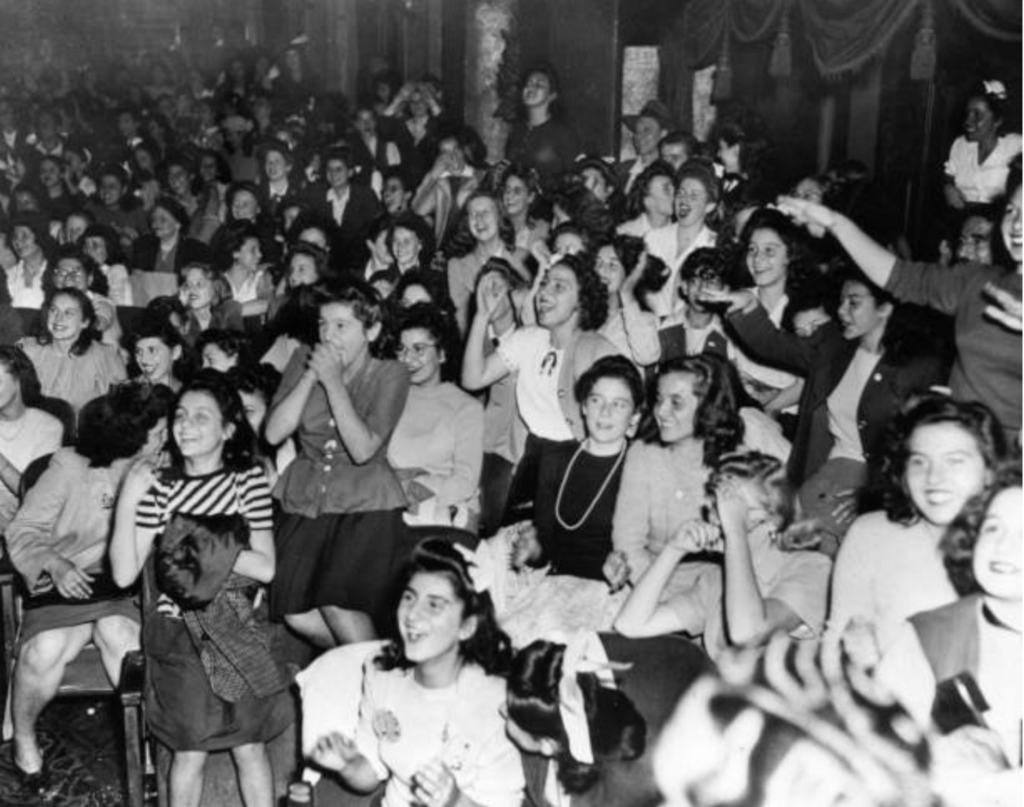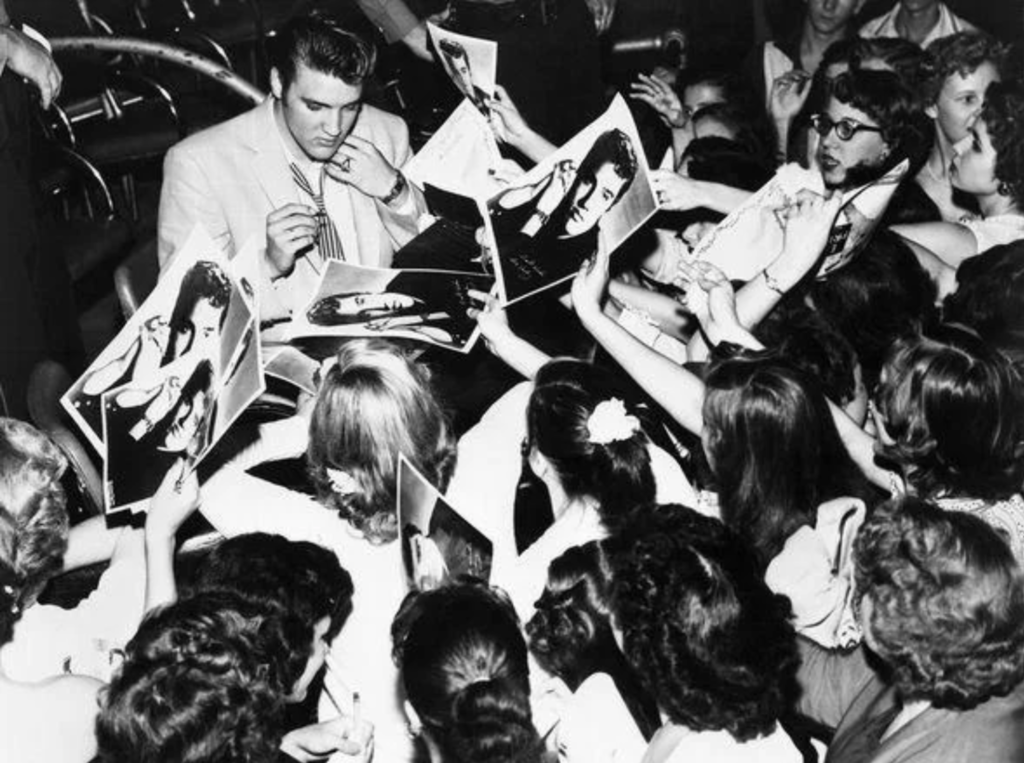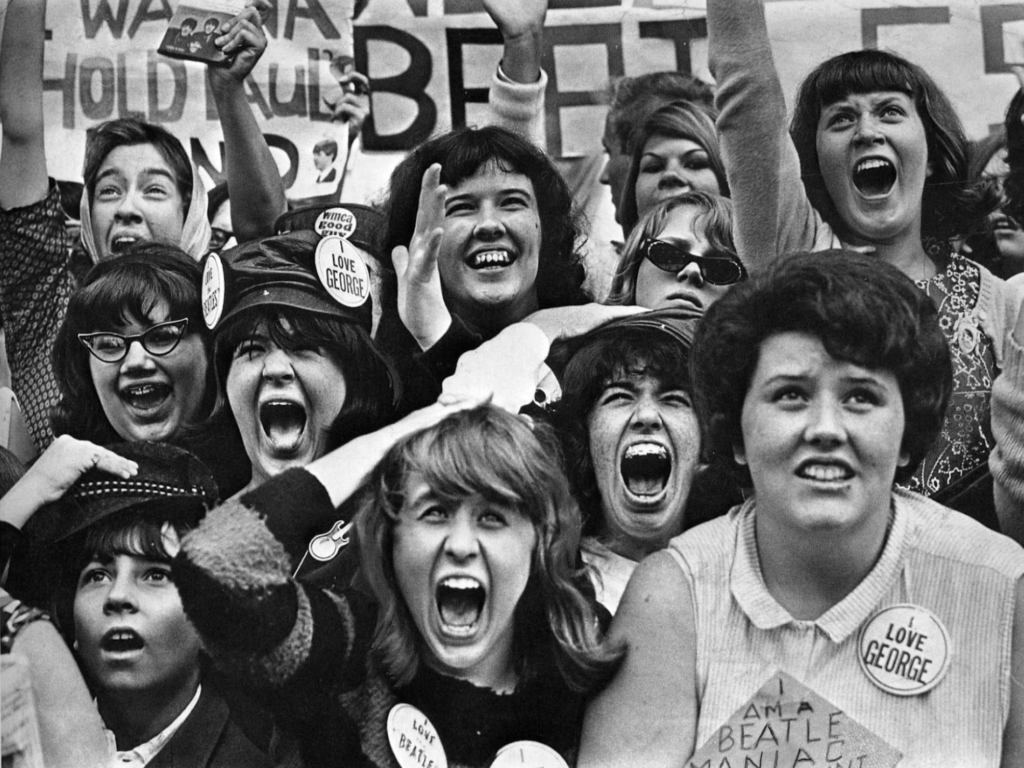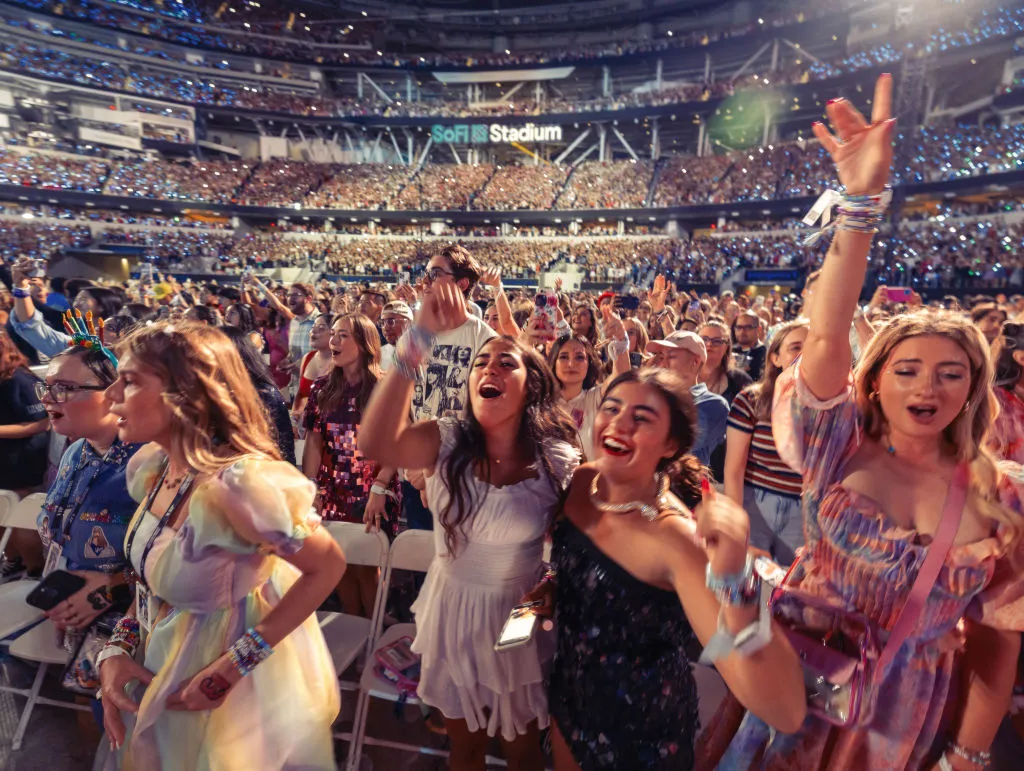Cover: Fans at SoFi Stadium for Taylor Swift’s concert in Inglewood, Monday, August 7, 2023, for The Eras Tour. (Allen J. Schaben via Getty Images)
From exchanging friendship bracelets before Taylor Swift’s concerts, to wearing cowboy hats at Beyoncé’s Renaissance Tour, or dancing in feather boas at Harry Styles’ Love on Tour, fangirls are everywhere.
In every area of pop culture, and particularly music, fans are the very backbone of success. They are the reason artists, musicians, and actors are able to build prosperous careers. Yet, they are often dismissed or demonized in the media, especially if they are young girls.
“Those who flock round the Beatles, who scream themselves into hysteria, whose vacant faces flicker over the TV screen, are the least fortunate of their generation, the dull, the idle, the failures,” wrote journalist Paul Johnson in his infamous essay for New Statesman. Although the article would become one of the most criticized pieces in the history of the publication, this rhetoric of associating the “fangirl” to a group of frivolous and obsessed teenage girls is common in the media.
The phenomenon of the ‘fangirl’
If you’ve only ever enjoyed pop culture casually, you might be wondering what a fangirl even is. It is derived from the broader concept of ‘fandom,’ which describes a community of fans with a shared interest in a piece of media. The Cambridge Dictionary defines the fangirl as a “girl or young woman who is a fan of someone or something,” but she is actually often described as a fan behaving in an obsessive way, with a very negative connotation. However, taking a closer look at what it actually takes to be a fangirl, you will understand that there is more to it than so-called hysteria. Fangirls are actually a vital part of the success of the very pop culture they support, shaping the way the world enjoys music.
‘Fangirling,’ a neologism?
The term ‘fangirl’ is not new. It predates even the most mainstream artists, dating all the way back to 1844, when the German poet Heinrich Heine coined the word “Lisztomania” to describe the “true madness” that broke out at the concerts of Hungarian composer and pianist Franz Liszt, with women fanning themselves and fainting as he took the stage. The medical professionals dubbed the phenomena as a manic mental state, which was allegedly due to a contagious fever among these young women.
Then, in the late 1920s and early 30s, professor Allison McCracken credits Rudy Vallée and Bing Crosby as the “blueprint for a pop sensation,” after consulting Vallée’s personal archive of fan letters dating back to 1928, in the American Radio Archives. Women were writing to him to confess their emotional reactions to his music and how confused they were by the idea of falling in love with a voice they only heard through the radio.
It was only a decade later that the world of music saw the real beginnings of fandom culture, with Frank Sinatra and his “Bobby Soxers.” Grainy pictures from the time depicted his young female fans waiting outside venues to catch a glimpse of their idol as early as 1940, screaming and crying if they ever managed to touch him. The Guardian at the time even published a report describing a “remarkable phenomena of mass hysteria,” following the so-called Columbus Day Riot, when Sinatra returned to New York City’s Paramount Theater and more than 30,000 teenage girls caused a giant commotion outside the venue.

Fans at a Frank Sinatra concert, October 12, 1944 (Keystone, Getty Images)
Fangirls were already well implanted in the cultural sphere by then, but the frenzy that emerged around Elvis Presley and The Beatles in the 50s and 60s was unprecedented. Before the end of World War II, the youth were much less prominent in popular culture than they are today, and the concept of the ‘teenager’ as its own entity was still relatively new. It is only with the post-war baby boom that it became clear that youth culture was something advertisers could profit from.
When Elvis Presley came to prominence in the mid-50s, the teen idol was not really an established category of performer. For example, the Miami Daily News published an article on August 4, 1956, that read “Elvis can’t sing, can’t play the guitar, and can’t dance. Yet two thousand idiots per show yelp everytime he opens his mouth, plucks a guitar string, or shakes his pelvis like any striptease babe in town. What’s happening that makes these girls scream, faint, pay lavish devotion for these musicians?”
When Presley made his first appearance on The Ed Sullivan Show, 54 million people tuned in to watch, 82% of the American TV audience at the time, a record only to be broken by the Beatles in 1964. This was the show that truly made him a household name. Presley then skyrocketed into the cultural world in 1956, and part of what made him such a controversial figure was how he played into his sex appeal.

Elvis signing autographs for his fans, January 1st, 1956 (Bettman, Getty Images)
Although women enjoyed some newfound freedoms after their contribution to the World War II effort, America still retained conservative views towards how women should express their sexuality. They were expected to be homemakers and obey their husband, fitting in the image of the 1950s housewife. Therefore, for adults in 1956, Elvis Presley’s swiveling hips and rockabilly guitar was everything that was wrong with the country at the time. To teenagers, however, he represented an opportunity to express their desire for something socially forbidden: sex. Elvis’ performances quickly became synonymous with young women crowding the stage, hoping for a glimpse, touch, or kiss from their idol.
While girls screamed at Lizst, Sinatra, and Elvis, Beatlemania was on a different level. It was the early 1960s in America, 4,000 girls were waiting at the airport as the Beatles arrived in the country for the first time in their careers. The girls were screaming, crying and passing out, saying they are in love with the band and want to marry the members. Everyone thought they were crazy. “Don’t worry, it’s only Beatlemania,” said concert promoter Andi Lothian after booking the Beatles in Glasgow.

“Beatlemaniacs on the Loose,” August 28, 1964 (Carl T. Gosset Jr., The New York Times)
The baby boom meant that there were more teenagers than there had been for Elvis, with more money in their pockets. To love the Beatles in 1963 was to embrace modernity, as critic Jon Savage wrote: “Big events were happening in the world, and pop was intimately connected to them. It wasn’t just entertainment.” While mainstream culture was increasingly sexualised, teenage girls were still expected to reflect purity. “To abandon control—to scream, faint, dash about in mobs—was, in form if not in conscious intent, to protest the sexual repressiveness, the rigid double standard of female teen culture,” wrote writer Barbara Ehrenreich about Beatles fans. “It was the first and most dramatic uprising of women’s sexual revolution.”
The fangirls determine your next favorite artist
As Harry Styles, former member of One Direction, said for his interview with Rolling Stones: “Who’s to say that young girls who like pop music—short for popular, right?—have worse musical taste than a 30-year-old hipster guy? That’s not up to you to say. Young girls like the Beatles. You gonna tell me they’re not serious? How can you say young girls don’t get it? They’re our future. Our future doctors, lawyers, mothers, presidents, they kind of keep the world going. Teenage-girl fans—they don’t lie. If they like you, they’re there. They don’t act ‘too cool’. They like you and they tell you. Which is sick.” And as the American music critic Jessica Hopper once tweeted: “Replace the word ’fangirl’ with ‘expert’ and see what happens.”
The Beatles were originally looked down upon for being a “boyband” who didn’t write their own music and only appealed to girls. Thanks to their loyal fanbase, they gained confidence in their artistry and began experimenting with their sound to become the Beatles we are now familiar with. Older men now take credit for appreciating the Beatles, because they’re a “real band,” yet nobody listened to the fangirls all those years ago when they expressed their appreciation and love for the group’s music.
In their early years, the media qualified the Beatles as “a near disaster…not merely awful but so unbelievably horrible, so appallingly unmusical…that they qualify as the crowned heads of anti-music.” Their music was regarded as “nothing more than noise,” highlighting that “the sounds of popular music are not designed for the parents, they are designed for the kids.” Still, these “kids,” qualified by Billboard as 14 to 15-year-old girls, were responsible for the group’s success, as early as 1963 with 12,000,000 copies of I Want to Hold Your Hand sold, and $50 million generated by merchandise sales in 1964, equivalent to over $500 million in today’s currency. As Sasha Geffen wrote in her book Glitter Up the Dark: How Pop Music Broke the Binary, “Without Beatles girls, there’s no Beatles.”
Still, it appears that once teenage girls express an interest in something, that thing becomes embarrassing to the rest of the world. Then, when they back off, society is suddenly able to appreciate them. From Frank Sinatra to Elvis and the Beatles, teen female fans have played pivotal roles in identifying the “greats” and single-handedly elevating their career, but they remain under-appreciated for their influence.
What many people fail to realise is that fangirls make up the majority of the music business. Some estimate that between 50% and 80% of an artist’s revenue come from the “superfans,” mainly young women, and that only 100 superfans are needed for an artist to thrive. The fangirls are therefore essential for the survival of artists and their long-term success. They often spot talent early, through social media platforms like TikTok, Instagram or Youtube, or supporting opening acts on major tours. They then are responsible for creating the hype, by sharing edits, memes, and performances of their new favorite artist. They coordinate streaming parties, buy multiple versions of albums, and request songs to be played on the radio to help songs chart. When a label fails to market their artist properly, you can be sure that the fangirls will develop projects on social media with people all around the globe in the span of a couple of hours, to bring recognition to their new favorite songs. In 2015, for example, One Direction had a song called “No Control” that the fans believed should have been a single. They started the #ProjectNoControl and got it trending worldwide, believing they could better promote the band’s album than their record label. The song earned so much attention that it was broadcast on BBC Radio 1 in the UK, and rose to No. 1 on the Billboard charts, proving once again the power of the teenage girls.
The fangirl is not just a fan, they are the fan. The one who can get a low-charting album to Gold in just a number of weeks. The one who can sell out arenas within seconds to an artist you hadn’t even heard of. The one that will buy both the physical album and every single on iTunes, will wear merch everyday, and dedicate their entire free time to running update accounts for no reason other than admiration. The fangirl is not only the greatest supporter, they’re an artist’s best publicist.
Fangirls as an economic driver
‘Superfans,’ according to a Luminate report, spend 80% more on music each month than the average US-based music listener. In addition, women have a larger influence over spending than they get credit for, controlling 85% of consumer spending in the United States, and totaling $31.8 trillion in worldwide spending. So when you’re wondering what customer base companies should be gearing towards, it’s women. A female fan is not just a committed enthusiast, but a committed consumer. Jamie Cohen, an American doctor in media studies, highlights that “the fangirl economy is far more powerful [than the attention economy] because a small group of passionate users is far more valuable than millions of flash-in-the-pan trend followers.” While the modern consumer can develop a brief interest in many things, the fangirl will stay dedicated and supportive in the long run.
Young women today are working more and earning more than ever before. By getting married and having children later in life, millennials and Gen Z have the disposable income and time necessary to dedicate a portion of their life to their favorite artists. The summer of 2023 marked a turning point, with Taylor Swift’s Eras Tour and Beyoncé’s Renaissance tour. These weren’t just high-grossing tours, they were full-on events, with unofficial dress codes (sequins for Taylor, cowboy chic for Beyoncé) and community-building activities such as Swifties trading friendship bracelets. Beyond selling out stadiums, these tours enabled fangirls to have an impact on the very economies of countries.
Fangirls’ spending and engagement stretches far beyond the concert stage, driving billions in revenue and revitalizing entire local economies. For instance, Taylor Swift’s Eras Tour grossed over $2 billion in ticket sales, making it the highest-grossing tour to date. In the United States alone, the tour generated an additional $200 million from merchandise sales and approximately $5 billion in consumer spending, boosting cities’ local GDPs. In 2023, former Canadian Prime Minister Justin Trudeau publicly invited Taylor Swift to perform in Canada after seeing the staggering economic data from her US tour. When Swift ultimately performed in Toronto, the local tourism office estimated her shows generated $282 million CAD for the city’s economy.
These tours don’t just fill arenas, they stimulate local economies, create jobs, and boost tax revenues, making fangirls integral to sustaining the broader entertainment industry. Fangirls have an important responsibility in keeping concert venues and live music alive.
The double standards in the entertainment industry
The sexist narrative that fangirls are nothing but shallow, hysterical teenagers is long outdated. So how come this stereotype still prevails?
From Bobby Soxers and Beatlemaniacs to Directioners, Swifties, and Beliebers, female pop fans have long been categorized as hysterical and mentally ill. Since we are now more desensitized to the idea of male artists shaking their hips onstage to appeal to teenage girls, the public outrage has shifted into a more general cynicism about the pop music industry with an overall clear message: male musical appreciation has to do with a deep understanding of artistry while girls are driven by idolatry and lust.
Artists become recognized only once they are no longer mainly associated with fangirls. The general public consensus is that there is apparently nothing more shameful than to be loved by teenage girls and men are the right fans to have. This is why rock is considered cooler than pop, acid house cooler than disco, prog cooler than boy bands. Take for instance 1975 singer Matthew Healy who talked about “hysteria” to qualify his fans, or Josh Francheschi, singer of You Me At Six, who expressed his satisfaction of no longer being “a cute band for girls.”
In parallel, artists with a remaining mainly-girl fan base are still delegitimized even when they are breaking records. Justin Bieber is the youngest solo musician ever to reach No. 1 on the Billboard 200, a record previously held by Elvis Presley since 1965; Taylor Swift is the only artist who won four Grammys for Album of the Year and the most decorated artist in Billboard Music Awards history; One Direction was the first UK group to debut at No.1 in the US with a debut album, and the first to debut at No.1 with their first four albums. Still, what comes to most minds when thinking about Bieber, Swift, or One Direction? That they are a “girl thing,” and not “real” artists because of their female fanbase.
Let’s take a look at sports fans. When looking in the stands of a football stadium, you’ll usually see a mostly male crowd roaring. Now, imagine a Harry Styles concert and his mostly female crowd cheering. Both scenarios are simply people enjoying themselves, but gender stereotypes and sexism will make many people consider the fangirls as hysterical.
Sports fans are incredibly enthusiastic and loyal to the teams they support, from decking themselves out in merchandise to painting their favorite player’s number on their face. Take the 2014 World Cup, for instance, when Germany defeated Argentina and fans took to the streets, causing commotion by rioting, kicking shop entrances and taunting the police. At least 15 police officers were injured and 50 people were detained. Still, we rarely accuse men of mania.
This isn’t a bash on sports fans, simply a prime example of the double standards in the entertainment industry. It’s perfectly normal for a man to cosplay in another man’s jersey, but if a woman dresses up for a Harry Styles concert, it’s seen as some kind of oddity. But is it not the same thing? A passion for what they love? The reality is that fandom is fandom. But, to quote Taylor Swift, “a man is allowed to react, a woman can only overreact.”
So where does that leave us?
Ultimately, an artist is only as powerful as their fanbase. So when paying respect to some of the greatest musicians in history, like the Beatles or Elvis, we must also pay respect to all the teenage girls who backed them from the very first day. Instead of ridiculing their dedication, we should acknowledge their impact and power: fangirls are not simple spectators, they are a crucial driving force in the music industry.
Other posts that may interest you:
- With the AWSN, Has the Time Finally Come for Women’s Sports ?
- Do You Slay?
- The Eras Tour : La tournée de tous les records tire sa révérence
- Is Brat Summer Really Over?
- “Now and Then” aux Grammy Awards : Quand l’intelligence artificielle ressuscite les Beatles
Discover more from The Sundial Press
Subscribe to get the latest posts sent to your email.





